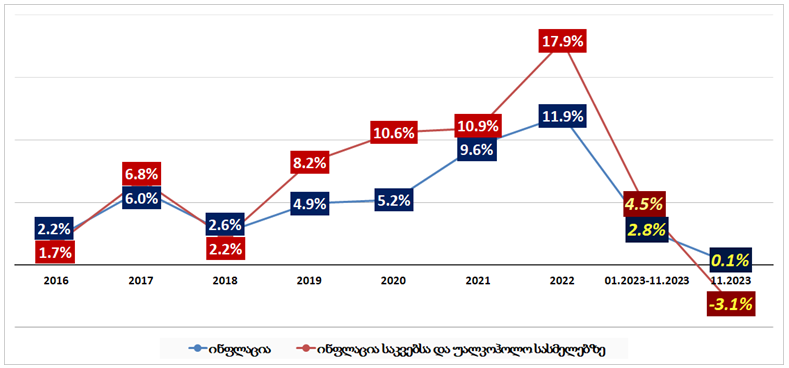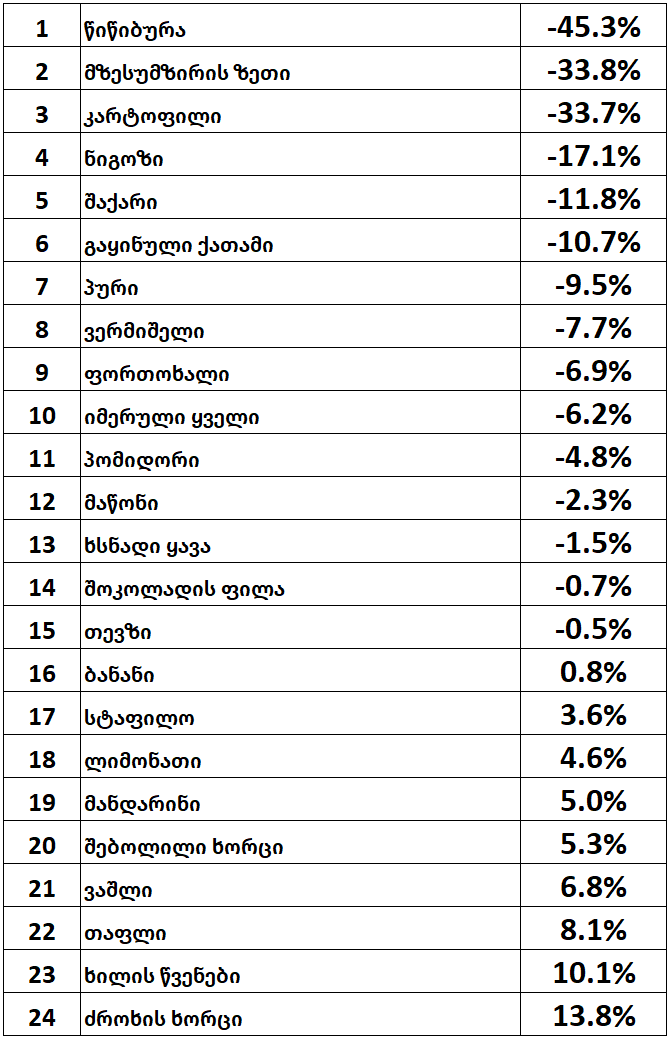Levan Davitashvili: “Food prices decreased in November.”
Verdict: FactCheck concludes that Levan Davitashvili’s statement is TRUE.
GeoStat calculates the change in the prices of consumer products by categorising 305 goods in 12 groups and comparing them to the previous month as well as to the same period of the previous year.
Each group is assigned its own weight out of which the highest weight is given to goods and non-alcoholic beverages at 32.2%.
Since April 2023, the annual (as compared to the corresponding period the previous year) inflation has fallen below the 3% mark and it also fell below 1% in July. In November, a mere 0.1% was observed in the growth of the prices of consumer goods. Additionally, the prices for these goods increased by 3.1% as compared to November 2022 and decreased by 0.5% as compared to October of this year. Keeping factual accuracy and a correctly evaluated tendency in mind, FactCheck concludes that Levan Davitashvili’s statement is TRUE.
Analysis:
On December 4, during the briefing following the session of the Government of Georgia, the Minister of Economy and Sustainable Growth, Levan Davitashvili, commented on the decreasing tendency of inflation and stated that deflation has been observed in consumer good prices (from 2:11): “Inflation amounted to 0.1% in November; inflation in November, as compared to the previous month, has decreased by 0.2 of a percentage point and, as compared to April, inflation has fallen below the target mark… It is especially noteworthy that, applying all of these dry numbers to real life, the prices of consumer goods have fallen not only with regard to the previous month but also to last year.”
Price stability is one of the primary objectives and functions (Article 3) of the National Bank of Georgia. “Stable prices” does not imply freezing them at a singular point; rather, the inflation target is 3%. In the 2019-2022 period, inflation could not be kept at its target value for four consecutive times. Inflation reached a particularly high point in 2021-2022. In the two-year period, the average consumer price index increased by 22.6%, including a 30.7% growth in food prices.
Inflation corresponds to the change in the prices of 305 consumer goods categorised into 12 groups. Ninety-two out of the 305 products are from the group of food and non-alcoholic beverages, accounting for the largest effect on inflation at a weight of 32.2%. Food prices are especially significant for low-income consumers.
The consumption basket includes other goods and services such as household items (a hammer and nails, for example) and photo printing. However, the increase or decrease in the price of a hammer is not reflected in the expenses of most people. However, a similar point cannot be made about food products.
Graph 1: Annual Inflation

Source: National Statistics Office of Georgia
Higher-than-average inflation on food products increased the expenditures of a significant proportion of the population, especially those with low incomes. In December 2022, the subsistence minimum had risen from GEL 175 to GEL 254, amounting to a 45% increase as compared to December 2018.
Food prices experienced a higher-than-average rate of growth at the beginning of 2023, although the situation changed in October. In October and November, a deflation of 1.2% and then 3.1% was observed consecutively as compared to the average of the same period last year.
Graph 1: Annual Inflation on Several Food Products

Source: National Statistics Office of Georgia
Prices have changed as compared to October as well; however, making a comparison only on selected products is valid due to seasonality. As usual, the prices of fruits and vegetables typically rise whereas prices of citrus decrease in November.
Deflation tends to pose long-term challenges for the economy; however, in this particular case, the reason was not a reduction in demand but rather only a partial adjustment. In November 2022, the prices of food and non-alcoholic beverages rose by 16.8% as compared to November 2021. Overall, the prices of the goods included in this group have nevertheless increased by 13.2% in the two years despite the recent trend of a downward pressure on prices.
Since April, inflation has indeed fallen below the target mark of 3%; moreover, deflation was observed in food and non-alcoholic beverages in November. The Minister of Economy’s statement correctly reflects the data as well as the evaluation of the realised trends. Thus, FactCheck concludes that Levan Davitashvili’s statement is TRUE.








